Individuals with disabilities may face situations where contaminated waste removal becomes essential for managing daily activities. This often arises due to medical conditions, mobility limitations, or specialised care needs that generate hazardous waste. It’s important to understand if the National Disability Insurance Scheme (NDIS) covers this service, as it plays a key role in maintaining health and safety. This article explores the eligibility of contaminated waste removal within NDIS plans, outlines what the service involves, and provides guidance on how participants can access the appropriate support to ensure their living environment remains clean and safe.
What is contaminated waste removal?
Contaminated waste removal refers to disposing of hazardous waste materials in a safe and regulated manner. This can include medical waste, bodily fluids, or any other waste that poses a health risk. The importance of proper contaminated waste removal cannot be overstated, as it ensures the safety and well-being of individuals, carers, and the general community.
- Types of contaminated waste: Includes sharps, bodily fluids, contaminated dressings, and hazardous materials.
- Health risks: Exposure to contaminated waste can lead to infections, diseases, or other severe health complications.
- Regulations: Strict protocols are in place to handle, store, and dispose of hazardous waste to avoid contamination.
- Disposal methods: Waste is often treated, disinfected, and disposed of according to national standards.
Contaminated waste removal is essential to ensuring personal safety and environmental protection.
Why is it important for people with disabilities?
For people with disabilities, contaminated waste removal may be more than just a necessity—it could be a matter of health and safety. Many individuals with disabilities face additional challenges related to personal care, which may result in the generation of waste that requires special handling.
- Health concerns: Some individuals may have medical conditions or impairments that increase the risk of exposure to harmful waste.
- Independence: By having access to safe waste removal services, individuals can maintain their independence without relying on others for hazardous waste disposal.
- Carer and family safety: Handling contaminated waste properly protects carers and family members from health risks.
- Social inclusion: A clean and safe environment allows for better participation in community and social activities, contributing to overall well-being.
Contaminated waste removal ensures that individuals with disabilities can live in a safe, hygienic environment, promoting independence and a higher quality of life.
When might contaminated waste removal be needed?
For individuals with disabilities, particularly those with medical needs, the removal of contaminated waste often necessitates stringent safety protocols. This is where the benefits of NDIS rubbish removal for household safety become clear. Proper disposal through such services is substantial, effectively preventing the accumulation of unattended hazardous materials and ensuring a safer living environment.
- Medical waste: Individuals who require ongoing medical treatments, such as injections or wound care, may generate contaminated waste that needs proper disposal.
- Incontinence care: For those with incontinence, the disposal of used products such as nappies and pads requires special handling to avoid contamination.
- Post-surgery care: After surgical procedures, properly discarding waste such as dressings or surgical equipment helps prevent infection.
- Daily care routines: Personal care tasks like bathing and dressing may generate waste that requires safe disposal.
It’s essential to have these services readily available when required to ensure safety and compliance with health standards. In some cases, contaminated green waste, such as that generated from infested or dying trees, may also require special handling; for example, if you’re dealing with decaying native flora, you might want to learn which pests infest dying Acacia trees and how they can pose biohazard risks.
Is it considered a reasonable and necessary support?
When accessing support under the NDIS, participants often question if services like contaminated waste removal are “reasonable and necessary.” Understanding these terms ensures that supports meet individual needs and allows informed service decisions.
Criteria | Reasonable Support | Necessary Support | Contaminated Waste Removal |
Related to Disability | Must improve daily living | Must directly address disability-related needs | Essential for health and safety |
Effectiveness | Improves quality of life | Crucial for safety or well-being | Prevents health risks |
Cost-Effectiveness | Should offer value | Must be affordable and essential | Justified to prevent harm
|
Ultimately, applying for NDIS rubbish removal assistance as a reasonable and necessary support will depend on your NDIS plan and the services that best align with your needs.
Who is responsible for organising contaminated waste removal?
The service providers typically have the responsibility for organising contaminated waste removal, but participants or their carers need to be aware of the support options available through the NDIS.

- NDIS participants: While participants may not directly handle the waste removal, they are responsible for ensuring that their care plan includes necessary supports such as waste management.
- Carers and families: In some cases, carers or family members may play a role in organising these services through NDIS-funded providers or private companies.
- NDIS service providers: Professional providers who specialise in disability care often take the lead in organising waste removal when it’s a critical aspect of their support services.
- Health professionals: Doctors or specialists may also recommend waste removal services if they identify a need based on the individual’s health condition.
To ensure the efficient management of contaminated waste removal, it’s important to understand who to contact and their responsibilities. If unsure, consult Australia’s official resources for disability support to find relevant service providers and planning tools.
How to apply for waste removal services through your NDIS plan
If you require contaminated waste removal as part of your care, applying for these services through your NDIS plan is straightforward. Below are the steps you can take to access this support:
- Review your NDIS plan: Check your existing NDIS plan to see if waste removal services are already included. If not, you may need to request a review or update.
- Speak with your support coordinator: If you have a support coordinator, they can assist you in identifying and organising the appropriate waste removal services.
- Choose a provider: Look for NDIS-registered providers offering contaminated waste removal services. Additionally, your support coordinator can help you find the right provider.
- Submit a service request: Once you’ve identified a provider, you can request the service. If your plan covers it, the provider arranges the necessary waste removal.
Conclusion
Waste removal is an essential service that supports individuals with disabilities, ensuring their health and safety. Understanding how to access these services through your NDIS plan can make all the difference, whether it’s for medical needs, incontinence, or daily care routines. Work with your NDIS provider and healthcare professionals to make sure your needs are met with dignity and respect.
To better understand how supports like this can fit into your plan, it may be helpful to see how Ahsan Care Provider approaches similar cases.


